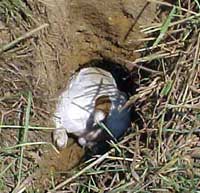History of the Jack Russell Terrier
Jack Russell Terriers are a type, or strain, of working terrier; they are not pure bred in the sense that they have a broad genetic make-up, a broad standard, and do not breed true to type.

 Jack Russell Terriers are a type, or strain, of working terrier; they are not pure bred in the sense that they have a broad genetic make-up, a broad standard, and do not breed true to type. This is a result of having been bred strictly for hunting since
their beginning in the early 1800's, and their preservation as a working breed since. The broad standard, varied genetic background based on years of restricted inbreeding and wide outcrossing, and great variety of size and type, are the major characteristics that make this strain of terrier known as a Jack Russell such a unique, versatile working terrier.
Jack Russell Terriers are a type, or strain, of working terrier; they are not pure bred in the sense that they have a broad genetic make-up, a broad standard, and do not breed true to type. This is a result of having been bred strictly for hunting since
their beginning in the early 1800's, and their preservation as a working breed since. The broad standard, varied genetic background based on years of restricted inbreeding and wide outcrossing, and great variety of size and type, are the major characteristics that make this strain of terrier known as a Jack Russell such a unique, versatile working terrier.
 The Jack Russell Terrier takes it name from the Reverend John Russell who bred one of the finest strains of terriers for working fox in Devonshire, England in the mid-to-late 1800's. Rev. Russell (1795-1883), apart from his church activities, had a passion for fox hunting and the breeding of fox hunting dogs; he is also said to be a rather flamboyant character, probably accounting for his strain of terrier's notability and the name of our terrier today. His first terrier, the immortal TRUMP, is said to be the foundation of John Russell's strain of working terriers.
The Jack Russell Terrier takes it name from the Reverend John Russell who bred one of the finest strains of terriers for working fox in Devonshire, England in the mid-to-late 1800's. Rev. Russell (1795-1883), apart from his church activities, had a passion for fox hunting and the breeding of fox hunting dogs; he is also said to be a rather flamboyant character, probably accounting for his strain of terrier's notability and the name of our terrier today. His first terrier, the immortal TRUMP, is said to be the foundation of John Russell's strain of working terriers.
Everything about the Jack Russell has fox hunting in mind... coloring, conformation, character, and intelligence. The body is compact, of totally balanced proportions, the shoulders clean, the legs straight, and most importantly, a small chest (easily spannable by average size hands at the widest part behind the shoulders). The Jack Russell must also be totally flexible, allowing him to maneuver underground. This conformation allows the terrier to follow his quarry down narrow earths. The fox is a good model for the Jack Russell-where the fox can go, so must the terrier. Although originally bred for fox hunting, the Jack Russell is a versatile working terrier to a variety of quarry including red and grey fox, raccoon and woodchuck.
John Russell maintained his strain of fox terriers bred strictly for working, and the terrier we know of today as the Jack Russell is much the same as the pre-1900 fox terrier. The Jack Russell has survived the changes that have occurred in the modern-day Fox Terrier because it has been preserved by working terrier enthusiasts in England for more than 100 years; it has survived on its merits as a worker. It is the foremost goal of the JRTCA that the Jack Russell continues in that tradition.
Opposed to Kennel Club Recognition
 The Fox Terrier, accepted as a kennel club breed in the late 1800's, has undergone many conformational changes as a result of the whims of the show ring, resulting in today's Modern Fox Terrier. Conformational changes such as a deep chest, long, narrow head structure, and extremely straight shoulders make it very unlikely that a fox terrier of today's standard could follow a fox into a shallow earth, even if the instinct to do so remained. John Russell maintained his strain of fox terriers bred strictly for working, and the terrier we know of today as the Jack Russell is much the same as the pre-1900 fox terrier. It is interesting to note that John Russell was one of the original founders of England's Kennel Club in 1873; in 1874, he judged Fox Terriers in the first Kennel Club sanctioned show in London. While he remained a Kennel Club member for the rest of his life, he did not exhibit his own dogs. The Jack Russell has survived the changes that have occurred in the modern-day Fox Terrier because it has been preserved by working terrier enthusiasts in England for more than 100 years; it has survived on its merit as a working. It is the foremost goal of the JRTCA that the Jack Russell continued in that tradition.
The Fox Terrier, accepted as a kennel club breed in the late 1800's, has undergone many conformational changes as a result of the whims of the show ring, resulting in today's Modern Fox Terrier. Conformational changes such as a deep chest, long, narrow head structure, and extremely straight shoulders make it very unlikely that a fox terrier of today's standard could follow a fox into a shallow earth, even if the instinct to do so remained. John Russell maintained his strain of fox terriers bred strictly for working, and the terrier we know of today as the Jack Russell is much the same as the pre-1900 fox terrier. It is interesting to note that John Russell was one of the original founders of England's Kennel Club in 1873; in 1874, he judged Fox Terriers in the first Kennel Club sanctioned show in London. While he remained a Kennel Club member for the rest of his life, he did not exhibit his own dogs. The Jack Russell has survived the changes that have occurred in the modern-day Fox Terrier because it has been preserved by working terrier enthusiasts in England for more than 100 years; it has survived on its merit as a working. It is the foremost goal of the JRTCA that the Jack Russell continued in that tradition.
There has been a great increase in the conformation showing of Jack Russell Terriers in recent years. Conformation exhibiting has been very effective in the U.S. in promoting correct conformation according to the JRTCA breed standard, thereby improving the quality of the breeding stock in this country.
 However, while showing is beneficial to the breed in that respect, the JRTCA designs its trials to keep the working aspects of the terrier in the forefront. The highest awards presented to a terrier by the JRTCA are its working awards; the Natural Hunting Certificate, the Bronze Medallion for Special Merit in the Field, and the Working Achievement Award for Continued Field Service.
However, while showing is beneficial to the breed in that respect, the JRTCA designs its trials to keep the working aspects of the terrier in the forefront. The highest awards presented to a terrier by the JRTCA are its working awards; the Natural Hunting Certificate, the Bronze Medallion for Special Merit in the Field, and the Working Achievement Award for Continued Field Service.
The JRTCA National Trial Conformation Champion is selected from the JRTCA Working Terrier Division of the National Trial; all entries have proven their working ability to having earned at least one Natural Hunting Certificate in the field. JRTCA sanctioned conformation judges are required to have an in-depth, first-hand knowledge of terrier work, and understand the importance of the physical characteristics necessary for a terrier to be useful for the work he was bred to do. These judges are required to work their terriers in the field.